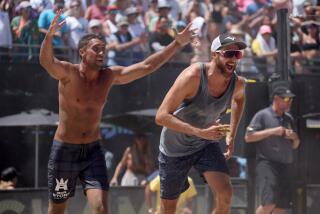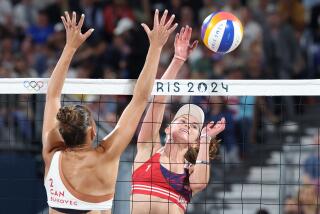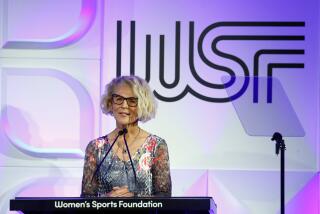Injuries Can’t Keep Veteran Volleyball Player Off Sandy Court
- Share via
Jon Stevenson was home. It was the Manhattan Beach Open, down the street from his alma mater, Mira Costa High School, and the back yard of childhood friend Mike Dodd, where he was introduced to volleyball.
Years later, it was Manhattan where Stevenson and Dodd made the big time, earning their AAA rating--the highest level in beach volleyball--with a third-place finish in the open in 1980.
But now another nine years had passed and a 32-year-old Stevenson was sure he was going to die on the hallowed sand courts below the Manhattan Beach Pier. A broken ankle in the off-season, a torn stomach muscle and, now, a recurring back injury had escorted the dreaded R word into his psyche.
Retirement .
“I was determined to do well at Manhattan,” said Stevenson, who was playing with 21-year-old Kent Steffes, a defector from the UCLA volleyball program, in the prestigious event. “My back felt good. It seemed cleared up, so I trained and trained. But I over -trained, and the injury came back (in the event’s early rounds).
“I just barely was able to finish. And here was Kent looking at me like, ‘Hey, this is Jon Stevenson? The guy who won all those tournaments?’ And I just wanted to get off the court.’ ”
But Stevenson stuck around and, going into this weekend’s USA Championship tournament at Hermosa Beach Pier, he has finished in the top four in seven consecutive events. The string was highlighted Aug. 12-13 when Stevenson and Steffes won the $100,000 Orange County Open in Seal Beach.
It was the first pro victory for Steffes, whose work on the beach circuit prompted the National Collegiate Athletic Assn. to declare him ineligible to play for UCLA. “But I think I was just as elated about winning Seal Beach as he was,” Stevenson said.
It felt a lot like last year, he said. Teamed with the 6-foot-5 Pat Powers, Stevenson earned more than $100,000 in 1988. Powers and Stevenson won six tournaments, trailing only the perennially dominant teams of Sinjin Smith-Randy Stoklos and Tim Hovland-Mike Dodd.
But for Powers--like Stevenson--injuries were devastating. He had rotator cuff surgery in the off-season and wasn’t able to join the tour until the Venice Open in late May.
“That first tournament, he just played on a lot of heart,” Stevenson said. “He couldn’t even lift his arm, but we won our pool anyway.”
The next week, Powers sat out and Stevenson played his first tournament with Steffes. The pair took third in the Santa Cruz Open, but Stevenson was already obligated to play with Powers in Boulder, Colo., two weekends later.
“I just said, ‘Sorry Kent,’ and went back with Pat,” he said. “Then I got hurt.”
Stevenson’s back injury, coupled with Powers’ frustration over the slow pace of his own recovery, eventually put a strain on the partnership.
“We wanted so desperately to get back to where we were last year,” Stevenson said. “He was such an awesome player. At courtside, jaws would drop. He’s just an animal. But early this year, I think his lack of ability to do certain things you have to do to win took a toll on him.
“Now Pat is very close to where he was last year. But it was tough for us to play together. He had his injuries and I had mine.”
So Stevenson went back to Steffes and, eventually, the winner’s circle.
“For me, it was really gratifying to win with Kent,” he said. “It was not only the first win for a player with a promising future, but it means that I’ve won with three guys--Kent, Pat and John Hanley. It’s another piece of evidence that I can win with different people.”
It’s also another piece of evidence that Stevenson can overcome adversity. Disadvantage No. 1 was painfully apparent when he walked into his first class at Mira Costa High. As a freshman, he was 5-foot-2.
“I was always a little bit smaller, but I was also a little quicker,” he said. Stevenson was still a standout point guard on the Mira Costa basketball team--he grew to 5-11 before he graduated--but in those early days he and an even shorter friend would entertain themselves taking Super-8 movies of each other slam dunking on 8-foot elementary school baskets.
Stevenson went to Brigham Young University to play basketball but eventually fell in love with beach volleyball and transferred to UC Santa Barbara, where he was an All-American indoor player and honor student.
At 6-feet, he was still relatively small for the beach game when he came out of school and played those first three tournaments with Dodd in 1980. But after getting the third-place finish in the Manhattan Beach Open, Dodd and Stevenson knocked off the top-seeded team of Smith and Karch Kiraly to gain a second in the World Championships a week later.
Stevenson had arrived.
“Some people knew who I was in Santa Barbara, but I was out of nowhere down here,” he recalled.
In 1984, in one of the highlights of his career, Stevenson and Hanley were the top point getters on the tour. But the next year Stevenson was again confronted by adversity.
The pro tour introduced the “blocking over” rule, which allowed players to reach over the net to block a spiked ball. The rule was perceived as making beach volleyball exclusively a big man’s game, and it did drive out some of the smaller players. But in the fifth season of the rule, Stevenson not only remains but has enjoyed more success.
“Before 1985, I had won nine tournaments,” he said. “And since then, I have won 14. So I don’t think (the rule) has hurt me too much.”
Stevenson has tried to make up for the height difference by trying to out-train opponents: “I’ve always placed a high emphasis on training to be competitive with the bigger guys.”
So it’s ironic that it was training that indirectly led to his next brush with adversity. Over the winter, he slipped on a quarter at the gym and broke his ankle.
“It was a freak accident,” Stevenson said. “I did my best to stick with my (rehabilitation) schedule. But I was doing jumps when I shouldn’t have been doing them yet when I hurt my stomach.”
Despite what he later learned was a torn stomach muscle, he accepted an invitation to play in an international beach tournament in Brazil in late February. There he irritated the injury and was forced to sit out the next two tournaments. And later the stomach tear led to the back injury.
“A guy like me, I don’t want to sit on the court all day and play games to train,” Stevenson said. “Instead, I enjoy lifting weights and other kinds of training. But when you’re doing things like jump-training, you leave yourself open to injury a little more. So once I hurt my ankle, I was doomed.”
Stevenson says he’s healthy and enjoying life as Steffes’ teammate. But the partnership is less of the teacher-student situation than it appears. Steffes, a 6-foot-3 Pacific Palisades product, is not simply a star of the future who’s waiting for his chance to take over, according to Stevenson.
“The way I look at it is, in a way, he’s taking over now,” he said. “He just won a $100,000 tournament at 21. He’s impressed me a lot. He’s handled his success well. When I first met him, I could tell he was beyond his years in savvy.
“There are some things I’ve taught him, sure. But you’d be surprised how even a partnership this is.”
Stevenson, who still lives in Manhattan Beach, has done his share of teaching. He regularly writes a column on technique for Volleyball Monthly as an associate editor, and he has written a textbook on the beach game called “Hot Sand.”
But now, Stevenson has branched out into another medium. He is working as technical consultant for a feature film on beach volleyball, “Side Out,” that is in production.
More to Read
Go beyond the scoreboard
Get the latest on L.A.'s teams in the daily Sports Report newsletter.
You may occasionally receive promotional content from the Los Angeles Times.










